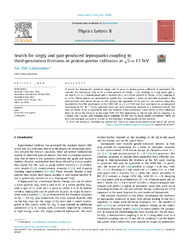Search for singly and pair-produced leptoquarks coupling to third-generation fermions in proton-proton collisions at √s = 13 TeV
| dc.contributor.author | Sirunyan, A. M. | |
| dc.contributor.author | Işıldak, Bora | |
| dc.date.accessioned | 2023-05-11T11:13:47Z | |
| dc.date.available | 2023-05-11T11:13:47Z | |
| dc.date.issued | 2021-08-10 | |
| dc.identifier.issn | 0370-2693 | en_US |
| dc.identifier.uri | http://hdl.handle.net/10679/8244 | |
| dc.identifier.uri | https://www.sciencedirect.com/science/article/pii/S0370269321003865 | |
| dc.description.abstract | A search for leptoquarks produced singly and in pairs in proton-proton collisions is presented. We consider the leptoquark (LQ) to be a scalar particle of charge −1/3e coupling to a top quark plus a tau lepton (tτ) or a bottom quark plus a neutrino (bν), or a vector particle of charge +2/3e, coupling to tν or bτ. These choices are motivated by models that can explain a series of anomalies observed in the measurement of B meson decays. In this analysis the signatures tτνb and tτν are probed, using data recorded by the CMS experiment at the CERN LHC at s=13 TeV and that correspond to an integrated luminosity of 137 fb−1. These signatures have not been previously explored in a dedicated search. The data are found to be in agreement with the standard model prediction. Lower limits at 95% confidence level are set on the LQ mass in the range 0.98–1.73 TeV, depending on the LQ spin and its coupling λ to a lepton and a quark, and assuming equal couplings for the two LQ decay modes considered. These are the most stringent constraints to date on the existence of leptoquarks in this scenario. | en_US |
| dc.description.sponsorship | BMBWF and FWF (Austria); FNRS and FWO (Belgium); CNPq, CAPES, FAPERJ, FAPERGS, and FAPESP (Brazil); MES (Bulgaria); CERN; CAS, MOST, and NSFC (China); COLCIENCIAS (Colombia); MSES and CSF (Croatia); RIF (Cyprus); SENESCYT (Ecuador); MoER, ERC PUT and ERDF (Estonia); Academy of Finland, MEC, and HIP (Finland); CEA and CNRS/IN2P3 (France); BMBF, DFG, and HGF (Germany); GSRT (Greece); NKFIA (Hungary); DAE and DST (India); IPM (Iran); SFI (Ireland); INFN (Italy); MSIP and NRF (Republic of Korea); MES (Latvia); LAS (Lithuania); MOE and UM (Malaysia); BUAP, CINVESTAV, CONACYT, LNS, SEP, and UASLP-FAI (Mexico); MOS (Montenegro); MBIE (New Zealand); PAEC (Pakistan); MSHE and NSC (Poland); FCT (Portugal); JINR (Dubna); MON, ROSATOM, RAS, RFBR, and NRC KI (Russia); MESTD (Serbia); SEIDI, CPAN, PCTI, and FEDER (Spain); MoSTR(Sri Lanka); Swiss Funding Agencies (Switzerland); MST (Taipei); ThEPCenter, IPST, STAR, and NSTDA (Thailand); TUBITAK and TAEK (Turkey); NASU (Ukraine); STFC (United Kingdom); DOE and NSF (USA). Individuals have received support from the Marie-Curie program and the European Research Council and Horizon 2020 Grant, contract Nos. 675440, 724704, 752730, and 765710 (European Union); the Leventis Foundation; theA.P. Sloan Foundation; the Alexander von Humboldt Foundation; the Belgian Federal Science Policy Office; the Fonds pour la Formation a la Recherche dans l'Industrie et dans l'Agriculture (FRIA-Belgium); the Agentschap voor Innovatie door Wetenschap en Technologie (IWT-Belgium); the F.R.S. -FNRS and FWO (Belgium) under the "Excellence of Science -EOS" -be.h project n. 30820817; the Beijing Municipal Science & Technology Commission, No. Z191100007219010; The Ministry of Education, Youth and Sports(MEYS) of the Czech Republic; the Deutsche Forschungsgemeinschaft (DFG) under Germany's Excellence Strategy -EXC 2121 "Quantum Universe" -390833306; the Lendulet ("Momentum") Program and the Janos Bolyai Research Scholarship of the Hungarian Academy of Sciences, the New National Excellence Program UNKP, the NKFIA research grants 123842, 123959, 124845, 124850, 125105, 128713, 128786, and 129058 (Hungary); the Council of Science and Industrial Research, India; the HOMING PLUS program of the Foundation for Polish Science, cofinanced from European Union, Regional Development Fund, the Mobility Plus program of the Ministry of Science and Higher Education, the National Science Center (Poland), contracts Harmonia 2014/14/M/ST2/00428, Opus 2014/13/B/ST2/02543, 2014/15/B/ST2/03998, and 2015/19/B/ST2/02861, Sonata-bis 2012/07/E/ST2/01406; the National Priorities Research Program by Qatar National Research Fund; the Ministry of Science and Higher Education of the Russian Federation, project no. 0723-2020-0041 (Russia); the Tomsk Polytechnic University Competitiveness Enhancement Program; the Programa Estatal de Fomento de la Investigacion Cientifica y Tecnica de Excelencia Maria de Maeztu, grant MDM-2015-0509 and the Programa Severo Ochoa del Principado de Asturias; the Thalis and Aristeia programs cofinanced by EU-ESF and the Greek NSRF; the Rachadapisek Sompot Fund for Postdoctoral Fellowship, Chulalongkorn University and the Chulalongkorn Academic into Its 2nd Century Project Advancement Project (Thailand); the Kavli Foundation; the Nvidia Corporation; the SuperMicro Corporation; the Welch Foundation, contract C1845; and the Weston Havens Foundation (USA). | |
| dc.language.iso | eng | en_US |
| dc.publisher | Elsevier | en_US |
| dc.relation.ispartof | Physics Letters B | |
| dc.rights | openAccess | |
| dc.rights.uri | https://creativecommons.org/licenses/by/4.0/ | |
| dc.title | Search for singly and pair-produced leptoquarks coupling to third-generation fermions in proton-proton collisions at √s = 13 TeV | en_US |
| dc.type | Article | en_US |
| dc.description.version | Publisher version | en_US |
| dc.peerreviewed | yes | en_US |
| dc.publicationstatus | Published | en_US |
| dc.contributor.department | Özyeğin University | |
| dc.contributor.authorID | (ORCID 0000-0002-0283-5234 & YÖK ID 124605) Işıldak, Bora | |
| dc.contributor.ozuauthor | Işıldak, Bora | |
| dc.creator | The CMS Collaboration | |
| dc.identifier.volume | 819 | en_US |
| dc.identifier.wos | WOS:000679259200018 | |
| dc.identifier.doi | 10.1016/j.physletb.2021.136446 | en_US |
| dc.subject.keywords | CMS | en_US |
| dc.subject.keywords | Leptoquarks | en_US |
| dc.subject.keywords | Search for new physics | en_US |
| dc.identifier.scopus | SCOPUS:2-s2.0-85111238296 | |
| dc.relation.publicationcategory | Article - International Refereed Journal - Institutional Academic Staff |
Files in this item
This item appears in the following Collection(s)
Share this page




